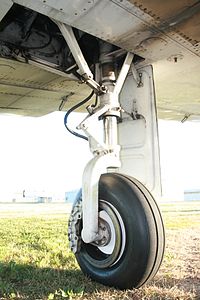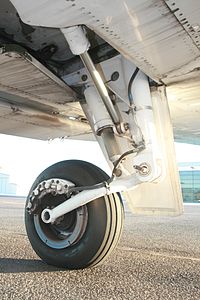Oleo strut
An oleo strut is a
It is undesirable for an airplane to bounce on landing as it could lead to a loss of control,
History
The original design for the oleo-pneumatic shock-absorbing strut was
The design proved to be viable and was extensively adopted across the aviation industry for fixed undercarriages, becoming simply referred to as an "Oleo unit" or undercarriage leg.

During 1926, the Cleveland Pneumatic Tool Company designed and introduced an oleo strut, one of the first to be purpose-designed for use on airplanes. The company subsequently marketed the product as an Aerol strut, which had entered widespread use within the United States within the space of a decade.[10][11][12][13] By 1931, innovations in the field were being made in the United Kingdom, France, and North America.[14] The oleo strut became commonly used for aviation purposes around the world.[3] By the twenty-first century, a wide range of different shock-absorbing struts were in use, but typically employ common principles, despite considerable variations in size, weight, and other characteristics.[15][16]
Refinements continued to be made to the technology behind the oleo strut. During 1954,
According to Engineering360, by 2019, the oleo-pneumatic strut had become the most common type of shock absorber in use on modern aircraft.[4] The oleo strut has seen much use on the largest cargo airplanes in the world, such as the Antonov An-124 Ruslan; it reportedly provides for a rough-field landing capacity while carrying payloads of up to 150 tons. This design also cushions the airframe from the impacts of taxiing, resulting in greater levels of comfort for passengers and crew.[21]
In non-aircraft use, the Quadro range of
Operation

An oleo strut consists of an inner metal tube or piston, which is attached to the wheel axle, and which moves up and down in an outer (or upper) metal tube, or cylinder, that is attached to the airframe. The cavity within the strut and piston is filled with gas (usually nitrogen, sometimes air—especially on light aircraft) and oil (usually hydraulic fluid), and is divided into two chambers that are connected by a small orifice of a precise, calculated size.[4][23]
When the aircraft is stationary on the ground, its weight is supported by the compressed gas in the cylinder.[1] During landing, or when the aircraft taxis over bumps, the piston slides up and down.[4] This movement compresses the gas, which acts as a spring, and forces oil through the orifice, which acts as a damper. A tapered rod is used on some designs to change the size of the orifice as the piston moves, providing greater resistance as compression of the strut increases. Additionally, a check valve is sometimes used to uncover additional orifices so that damping during compression is less than during rebound. Oleo struts absorb and dissipate forces by converting a portion of the accumulated kinetic energy into thermal energy.[4]
Pneumatic systems like the oleo strut generally have long operating lives, and the construction is not unusually complex for maintenance purposes.[24] Nitrogen is usually used as the gas instead of air, since it is less likely to cause corrosion. The various parts of the strut are sealed with O-rings or similar elastomeric seals, and a scraper ring is used to keep dust and grit adhering to the piston from entering the strut.[21]
See also
- FedEx Express Flight 80 – bounce during landing leading to crash
References
- ^ ISBN 978-0-07-069633-4. Retrieved 12 March 2011.
- ^ Welcome Guest Login Here. "Activities, Courses, Seminars & Webinars - ALC_Content - FAA - FAASTeam". FAASafety.gov. Retrieved 26 June 2016.
- ^ a b "Airframe Structural Design" (PDF). club66pro.com. pp. 456–460. Retrieved 17 June 2020.
- ^ a b c d e Olson, Eric (7 November 2019). "How do oleo-pneumatic shock struts work?". insights.globalspec.com.
- ^ "Flight Training Magazine - AOPA". Flighttraining.aopa.org. November 2004. Retrieved 26 June 2016.
- ^ Fri, 07/22/2011 (26 December 2008). "Oleo struts | Welcome to the P28B Web Site". P28b.com. Retrieved 26 June 2016.
{{cite web}}: CS1 maint: numeric names: authors list (link) - ^ a b c d "The Oleo Story". Oleo.co.uk. Retrieved 17 June 2020.
- ISSN 0002-2667.
- ^ "History". Oleo.co.uk. Retrieved 17 June 2020.
- ^ Cleveland. The Making of a City, p. 865.
- ^ "The Savvy Aviator #31: Know Your Oleo". avweb.com. 10 May 2006.
- ^ American Engineer's Feat Proves Boom to Aviation. Aeronautical World Journal of Commerce, 1930. Vol. 3-4, p. 34.
- ^ Absorbing the Shocks. US Air Services, 1931. Vol. 16, p. 48.
- ^ Dowty, G. H (May 1931). "Description of Landing Wheels with Oleo Strut". dowtyheritage.org.uk.
- ^ "Shock Strut - Aircraft Landing Gear Systems". aircraftsystemstech.com. Retrieved 17 June 2020.
- ^ "Oleo Strut Basics" (PDF). electricmotorglider.com. November 2006.
- ^ "Patent US2959410: Double stage oleo-pneumatic shock absorber". 1958. Retrieved 26 June 2016.
- Her Majesty's Stationery Office.
- ^ Asthana, Chandra B.; Rama B. Bhat (November 2012). "A Novel Design of Landing Gear Oleo Strut Damper using MR Fluid for Aircraft and UAV's". Applied Mechanics and Materials.
- S2CID 6531759.
- ^ ISBN 978-0-07-071704-6.
- ^ Radu, Mihnea (5 November 2014). "2015 Quadro 4 Pushes Leaning and Stability to Extremes at EICMA 2014". Retrieved 6 July 2016.
- ^ Twombly, Ian J (5 August 2013). "How it works". Aircraft Owners and Pilots Association.
- ^ Garrison, Peter (30 April 2012). "Sherlock and the Sagging Strut". Flying Magazine. Retrieved 26 June 2016.


